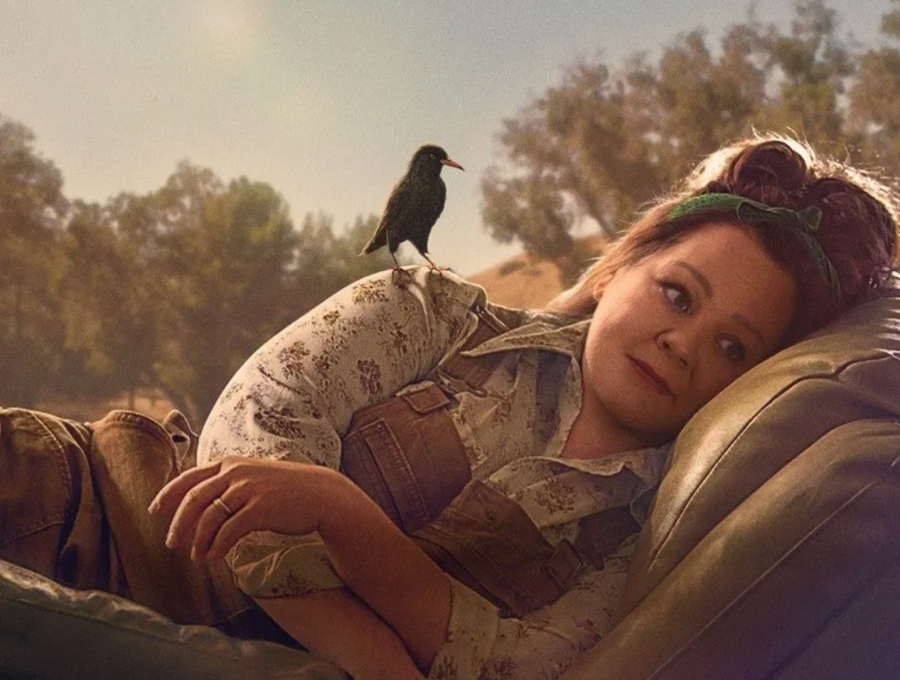“The Starling” fails to take flight
A poster for the Netflix Original, “The Starling”.
October 4, 2021
Symbolism in movies walks a dangerously thin line between being an incomprehensible mess and an obvious bludgeon beat continuously on the heads of the audiences. “The Starling” is one such film that uses symbolism to convey its themes and emotions within the piece. Directed by Theodore Melfi, it was released as a Netflix Original on the streaming platform to viewers on Sept. 24.
The film follows married Lilly (Melissa McCarthy) and Jack (Chris O’Dowd) Maynard as they navigate the aftermath of the loss of their one-year-old daughter, Katie. Chris falls into a depressive state and is checked into a mental health facility. Lilly, however, is left in their home to deal with her grief by herself.
Lilly and Jack’s marriage crumbles, and after meeting Jack at his facility, Lilly is referred a therapist to work through her own problems. However, it is revealed that the esteemed therapist, Larry Fine (Kevin Kline), quit his job to become a veterinarian years before Lilly met him. Thus, he helps Lilly unconventionally: dealing with the territorial starling that continuously attacks Lilly in her backyard.
The only positive aspect of the film was McCarthy and O’Dowd’s acting. They mesh well together on screen, and O’Dowd handles his depressive character in a realistic and respectful manner. McCarthy’s performance is particularly commendable as she is outside of her usual comedy comfort zone and manages to portray the suffering and heartache of losing a baby while juggling a crumbling marriage beautifully.
The starling is a prominent figure in the movie, representative of Jack and Lilly’s marriage. When Lilly throws a rock at the bird and nearly kills it after Jack requests that Lilly not visit him at the facility, one can see that quite literally, their marriage is on the rocks. However, it is after Lilly nurses the starling back to health that she and Jack are able to move forward past their anguish and issues.
Unfortunately, the starling as a motif works poorly in the movie due to how drawn out and obvious its role is. Nothing is left to viewer interpretation due to Matt Harris’ painfully clear writing, which seems as though it was meant for a five-year-old who has no analysis skills. After scene after scene of bird symbolism, Harris can’t help himself when he has Larry tell Kate that starlings are social animals who are meant to stay with each other and raise their young together, referencing Kate and Jack’s marriage for the umpteenth time. It doesn’t help that the CGI (Computer-Generated Imagery) for the bird is glaring, unsuccessful, and almost laughable.
As mentioned, the healing of the starling prompts the healing of the marriage. However, what occurs symbolically doesn’t translate into reality. Lilly spends day and night caring for the bird, dropping medicine down its beak, and playing music. Once the starling is set free, the marriage is simply magically restored. Lilly and Jack don’t make the same effort for their relationship. Thus, the symbolism fails in the resolution, which is the most crucial part of the movie.
Additionally, one of the film’s major pitfalls is that it attempts to pay partial homage to McCarthy’s roots as a ‘dramedy’. The playful moments in the film simply don’t fit because of the heavy topics that it traverses. As a result, the depression and sorrow that come with losing a child are grossly mishandled.
Lilly doesn’t understand why Jack is depressed and cannot function while she is still working and ‘better off’ despite the fact that she lost their kid along with him. Thus, she claims that she has been denying her own grief because of him, and goes further to call him selfish for attempting to take his life.
Lilly’s regressive notions would have been better incorporated in the movie if it clearly mentioned in some way that they were harmful, especially when aimed at a severely ill individual, due to the fact that many around the world hold such beliefs in regards to suicide and mental health. However, the film fails to educate its audience. Rather, this dialogue occurs during a ‘humorous’ moment, perpetuating and affirming Lilly’s behavior.
The film simply doesn’t resonate with its viewer. There are no hard-hitting moments despite the strong acting performances due to the lack of progress of plot made in the movie. Jack and Lilly really don’t evaluate and mend their relationship when the movie decides to bring them back together. Instead of true character development, we get a cliché, public, speech from Jack at the end of the movie.
Ultimately, I would recommend this movie to anyone who appreciated films like “Penguin Bloom”, as well as fans of Melissa McCarthy who would like to see her in a medium other than strict comedy.
3/10








